
Spring Semester, 2004
Memento, Prototype & Abstract Factory
© 2004, All Rights Reserved, SDSU & Roger Whitney
San Diego State University -- This page last updated 08-Mar-04

|
CS 635 Advanced Object-Oriented Design & Programming Spring Semester, 2004 Memento, Prototype & Abstract Factory |
|
|---|---|---|
|
© 2004, All Rights Reserved, SDSU & Roger Whitney San Diego State University -- This page last updated 08-Mar-04 |
Memento
Store an object's internal state, so the object can be restored to this state later without violating encapsulation
Motivation
Allow undo, rollbacks, etc.
Structure
Only originator:
Applicability
Use when you:
An Example
package Examples; class Memento { private Hashtable savedState = new Hashtable(); protected Memento() {}; //Give some protection protected void setState( String stateName, Object stateValue ) { savedState.put( stateName, stateValue ); } protected Object getState( String stateName) { return savedState.get( stateName); } protected Object getState(String stateName, Object defaultValue ) { if ( savedState.containsKey( stateName ) ) return savedState.get( stateName); else return defaultValue; } }
A Class whose state is saved
package Examples; class ComplexObject { private String name; private int someData; private Vector objectAsState = new Vector(); public Memento createMemento() { Memento currentState = new Memento(); currentState.setState( "name", name ); currentState.setState( "someData", new Integer(someData) ); currentState.setState( "objectAsState", objectAsState.clone() ); return currentState; } public void restoreState( Memento oldState) { name = (String) oldState.getState( "name", name ); objectAsState = (Vector) oldState.getState( "objectAsState" ); Integer data = (Integer) oldState.getState( "someData"); someData = data.intValue(); }
// Show a way to do incremental saves public Memento setName( String aName ) { Memento deltaState = saveAState( "name", name); name = aName; return deltaState; }
public void setSomeData( int value ) { someData = value; } private Memento saveAState(String stateName, Object stateValue) { Memento currentState = new Memento(); currentState.setState( stateName, stateValue ); return currentState; } }
Consequences/ Implementation
Simplifies Originator
You may be tempted to let the originator manage its state history
This adds to the complexity of the Originator
Defining Narrow and Wide Interfaces
C++
Class Memento {
public:
virtual ~Memento();
private:
friend class Originator;
Memento();
void setState(State*);
State* GetState();
...
Java[1]
class ComplexObject {
private String name;
private int someData;
public Memento createMemento() {
return new Memento();
}
public void restoreState( Memento oldState) {
oldState.restoreStateTo( this );
}
public class Memento {
private String savedName;
private int savedSomeData;
private Memento() {
savedName = name;
savedSomeData = someData;
}
private void restoreStateTo(ComplexObject target) {
target.name = savedName;
target.someData = savedSomeData;
}
}
}
Using Clone to Save State
One can wrap a clone of the Originator in a Memento or
Just return the clone as a type with no methods
interface Memento extends Cloneable { }
class ComplexObject implements Memento { private String name; private int someData; public Memento createMemento() { Memento myState = null; try { myState = (Memento) this.clone(); } catch (CloneNotSupportedException notReachable) { } return myState; } public void restoreState( Memento savedState) { ComplexObject myNewState = (ComplexObject)savedState; name = myNewState.name; someData = myNewState.someData; } }
Iterators & Mementos
Using a Memento we can allow multiple concurrent iterations
class IteratorState { int currentPosition = 0; protected IteratorState() {} protected int getPosition() { return currentPosition; } protected void advancePosition() { currentPosition++; } } class Vector { protected Object elementData[]; protected int elementCount; public IteratorState newIteration() { return new IteratorState(); } public boolean hasMoreElements(IteratorState aState) { return aState.getPosition() < elementCount; } public Object nextElement( IteratorState aState ) { if (hasMoreElements( aState ) ) { int currentPosition = aState.getPosition(); aState.advancePosition(); return elementData[currentPosition]; } throw new NoSuchElementException("VectorIterator"); } ...
Prototype
Intent
Specify the kinds of objects to create using a prototypical instance, and create new objects by copying this prototype
Applicability
Use the Prototype pattern when
Insurance Example
Insurance agents start with a standard policy and customize it
Two basic strategies:
Copying Issues
Shallow Copy Verse Deep Copy
Original Objects

Shallow Copy
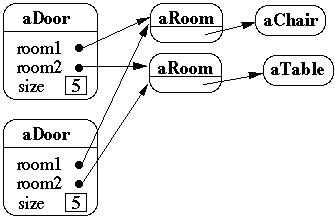
Shallow Copy Verse Deep Copy
Original Objects

Deep Copy
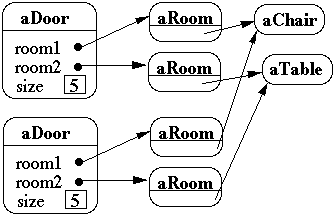
Shallow Copy Verse Deep CopyOriginal Objects

Deeper Copy
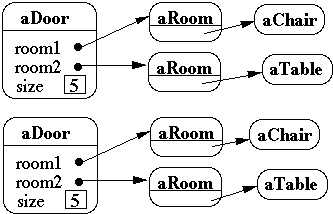
Cloning Issues
How to in C++ - Copy Constructors class Door { public: Door(); Door( const Door&); virtual Door* clone() const; virtual void Initialize( Room*, Room* ); // stuff not shown private: Room* room1; Room* room2; } Door::Door ( const Door& other ) //Copy constructor { room1 = other.room1; room2 = other.room2; } Door* Door::clone() const { return new Door( *this ); }
How to in Java - Object clone()
protected Object clone() throws CloneNotSupportedException
class Door implements Cloneable {
public void Initialize( Room a, Room b)
{ room1 = a; room2 = b; }
public Object clone() throws
CloneNotSupportedException {
// modify this method for deep copy
// no need to implement this method for shallow copy
return super.clone();
}
Room room1;
Room room2;
}
VisualWorks Smalltalk
Object>>shallowCopy Does a shallowCopy of the receiver
Object>>copy ^self shallowCopy postCopy “Template method for copy”
Copy is the primary method for copying an object
Classes override postCopy to do more than shallow copyDoor
Smalltalk.CS635 defineClass: #Door superclass: #{Core.Object} indexedType: #none private: false instanceVariableNames: 'room1 room2 '
postCopy room1 := room1 copy. room2 := room2 copy.
Consequences
Abstract Factory
Task - Write a cross platform window toolkit
GUI interfaces to run on
Create
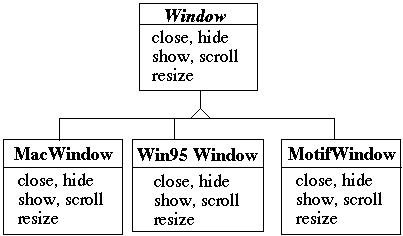
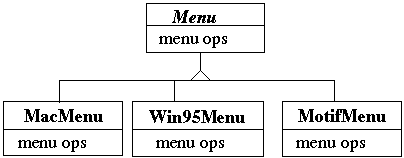
This allows the application to write to the widget interface
public void installDisneyMenu() { Menu disney = create a menu somehow disney.addItem( "Disney World" ); disney.addItem( "Donald Duck" ); disney.addItem( "Mickey Mouse" ); disney.addGrayBar( ); disney.addItem( "Minnie Mouse" ); disney.addItem( "Pluto" ); etc. }
How to create the widget so
Use Abstract Factory
abstract class WidgetFactory { public Window createWindow(); public Menu createMenu(); public Button createButton(); } class MacWidgetFactory extends WidgetFactory { public Window createWindow() { code to create a mac window } public Menu createMenu() { code to create a mac Menu } public Button createButton() { code to create a mac button } } class Win95WidgetFactory extends WidgetFactory { public Window createWindow() { code to create a Win95 window } public Menu createMenu() { code to create a Win95 Menu } public Button createButton() { code to create a Win95 button } }
Now to get code that works for all platforms we get:
public void installDisneyMenu(WidgetFactory myFactory) { Menu disney = myFactory.createMenu(); disney.addItem( "Disney World" ); disney.addItem( "Donald Duck" ); disney.addItem( "Mickey Mouse" ); disney.addGrayBar( ); disney.addItem( "Minnie Mouse" ); disney.addItem( "Pluto" ); etc. }
We just need to make sure that the application for each platform creates the proper factory
How Do Factories create Widgets?
Method 1) My Factory Method
abstract class WidgetFactory { public Window createWindow(); public Menu createMenu(); public Button createButton(); } class MacWidgetFactory extends WidgetFactory { public Window createWindow() { return new MacWidow() } public Menu createMenu() { return new MacMenu() } public Button createButton() { return new MacButton() } }
How Do Factories create Widgets? Method 2) Their Factory Method
abstract class WidgetFactory { private Window windowFactory; private Menu menuFactory; private Button buttonFactory; public Window createWindow() { return windowFactory.createWindow() } public Menu createMenu(); { return menuFactory.createMenu() } public Button createButton() { return buttonFactory.createMenu() } } class MacWidgetFactory extends WidgetFactory { public MacWidgetFactory() { windowFactory = new MacWindow(); menuFactory = new MacMenu(); buttonFactory = new MacButton(); } } class MacWindow extends Window { public Window createWindow() { blah } etc.
Method 2) Their Factory Method
When does this make Sense?
There might be more than one way to create a widget
abstract class WidgetFactory { private Window windowFactory; private Menu menuFactory; private Button buttonFactory; public Window createWindow() { return windowFactory.createWindow() } public Window createWindow( Rectangle size) { return windowFactory.createWindow( size ) } public Window createWindow( Rectangle size, String title) { return windowFactory.createWindow( size, title) } public Window createFancyWindow() { return windowFactory.createFancyWindow() } public Window createPlainWindow() { return windowFactory.createPlainWindow() }
Using factory method allows abstract class to do all the different ways to create a window.
Subclasses just provide the objects windowFactory, menuFactory, buttonFactory, etc.
How Do Factories create Widgets? Method 2.5) Subclass returns Class
abstract class WidgetFactory { public Window createWindow() { return windowClass().newInstance() } public Menu createMenu(); { return menuClass().newInstance() } public Button createButton() { return buttoneClass().newInstance() } public Class windowClass(); public Class menuClass(); public Class buttonClass(); } class MacWidgetFactory extends WidgetFactory { public Class windowClass() { return MacWindow.class; } public Class menuClass() { return MacMenu.class; } public Class buttonClass() { return MacButton.class; } }Smalltalk practice
Parent class normally does more complex stuff
How Do Factories create Widgets? Method 3) Prototype
class WidgetFactory { private Window windowPrototype; private Menu menuPrototype; private Button buttonPrototype; public WidgetFactory( Window windowPrototype, Menu menuPrototype, Button buttonPrototype) { this.windowPrototype = windowPrototype; this.menuPrototype = menuPrototype; this.buttonPrototype = buttonPrototype; } public Window createWindow() { return windowFactory.createWindow() } public Window createWindow( Rectangle size) { return windowFactory.createWindow( size ) } public Window createWindow( Rectangle size, String title) { return windowFactory.createWindow( size, title) } public Window createFancyWindow() { return windowFactory.createFancyWindow() } etc.
There is no need for subclasses of WidgetFactory.
Applicability
Use when
Consequences
Problem: Cheating Application Code
public void installDisneyMenu(WidgetFactory myFactory) { // We ship next week, I can't get the stupid generic Menu // to do the fancy Mac menu stuff // Windows version won't ship for 6 months // Will fix this later MacMenu disney = (MacMenu) myFactory.createMenu(); disney.addItem( "Disney World" ); disney.addItem( "Donald Duck" ); disney.addItem( "Mickey Mouse" ); disney.addMacGrayBar( ); disney.addItem( "Minnie Mouse" ); disney.addItem( "Pluto" ); etc. }
How to avoid this problem?
[1] RestoreStateTo does not access the fields of the outer object in case one wants to restore the state to a different ComplexObject object. One may wish to use an nested class to avoid tangling the memento to the outer object
Copyright ©, All rights reserved.
2004 SDSU & Roger Whitney, 5500 Campanile Drive, San Diego, CA 92182-7700 USA.
OpenContent license defines the copyright on this document.
Previous visitors since 08-Mar-04 Next